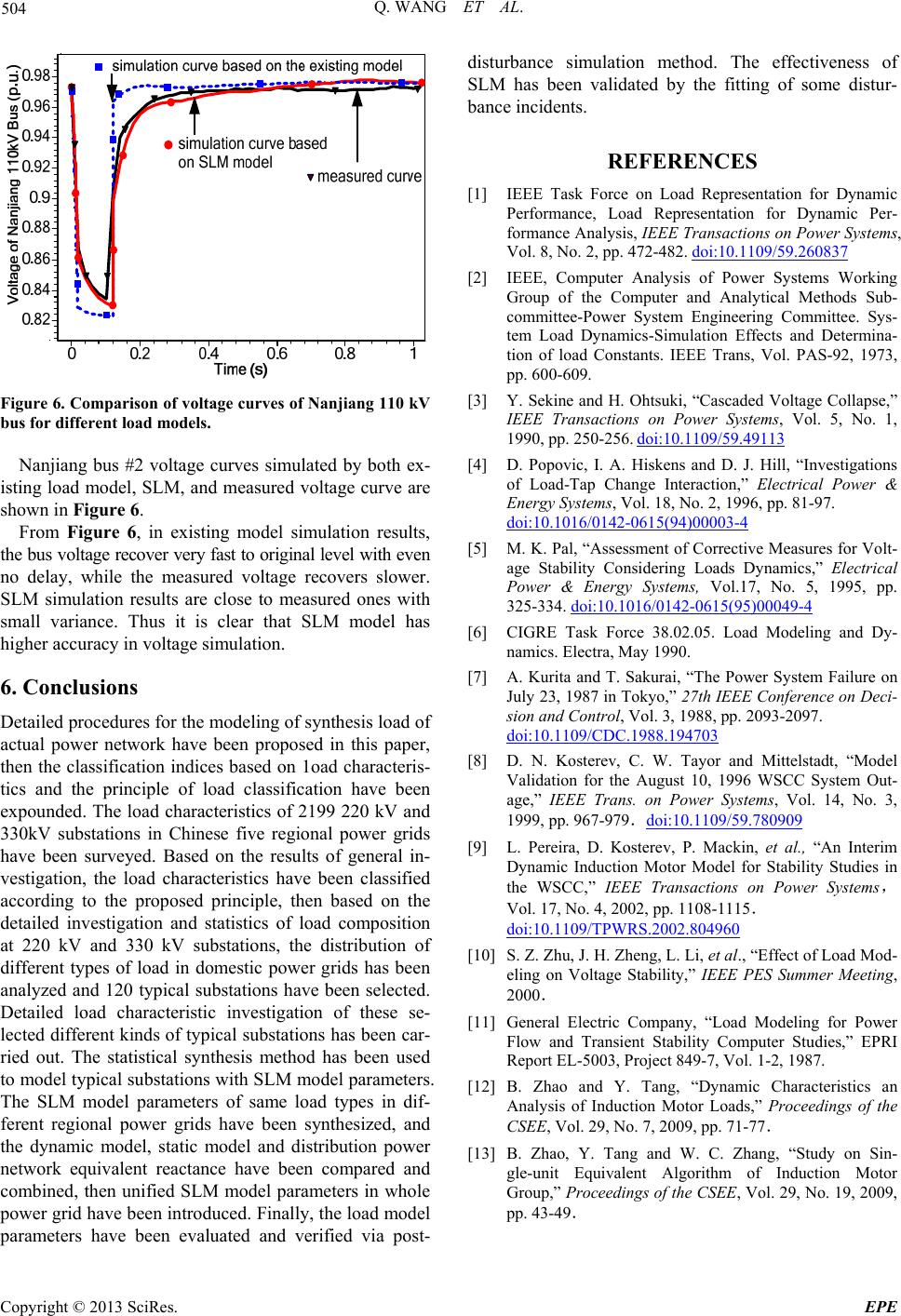
Q. WANG ET AL.
Copyright © 2013 SciRes. EPE
504
Figure 6. Comparison of voltage curves of Nanjiang 110 kV
bus for different load models.
Nanjiang bus #2 voltage curves simulated by both ex-
isting load model, SLM, and measured voltage curve are
shown in Figure 6.
From Figure 6, in existing model simulation results,
the bus voltage recover very fast to original level with even
no delay, while the measured voltage recovers slower.
SLM simulation results are close to measured ones with
small variance. Thus it is clear that SLM model has
higher accuracy in voltage simulation.
6. Conclusions
Detailed procedures for the modeling of synthesis load of
actual power network have been proposed in this paper,
then the classification indices based on 1oad characteris-
tics and the principle of load classification have been
expounded. The load characteristics of 2199 220 kV and
330kV substations in Chinese five regional power grids
have been surveyed. Based on the results of general in-
vestigation, the load characteristics have been classified
according to the proposed principle, then based on the
detailed investigation and statistics of load composition
at 220 kV and 330 kV substations, the distribution of
different types of load in domestic power grids has been
analyzed and 120 typical substations have been selected.
Detailed load characteristic investigation of these se-
lected different kinds of typical substations has been car-
ried out. The statistical synthesis method has been used
to model typical substations with SLM model parameters.
The SLM model parameters of same load types in dif-
ferent regional power grids have been synthesized, and
the dynamic model, static model and distribution power
network equivalent reactance have been compared and
combined, then unified SLM model parameters in whole
power grid have been introduced. Finally, the load model
arameters have been evaluated and verified via post-
disturbance simulation method. The effectiveness of
SLM has been validated by the fitting of some distur-
bance incidents.
REFERENCES
[1] IEEE Task Force on Load Representation for Dynamic
Performance, Load Representation for Dynamic Per-
formance Analysis, IEEE Transactions on Power Systems,
Vol. 8, No. 2, pp. 472-482. doi:10.1109/59.260837
[2] IEEE, Computer Analysis of Power Systems Working
Group of the Computer and Analytical Methods Sub-
committee-Power System Engineering Committee. Sys-
tem Load Dynamics-Simulation Effects and Determina-
tion of load Constants. IEEE Trans, Vol. PAS-92, 1973,
pp. 600-609.
[3] Y. Sekine and H. Ohtsuki, “Cascaded Voltage Collapse,”
IEEE Transactions on Power Systems, Vol. 5, No. 1,
1990, pp. 250-256. doi:10.1109/59.49113
[4] D. Popovic, I. A. Hiskens and D. J. Hill, “Investigations
of Load-Tap Change Interaction,” Electrical Power &
Energy Systems, Vol. 18, No. 2, 1996, pp. 81-97.
doi:10.1016/0142-0615(94)00003-4
[5] M. K. Pal, “Assessment of Corrective Measures for Volt-
age Stability Considering Loads Dynamics,” Electrical
Power & Energy Systems, Vol.17, No. 5, 1995, pp.
325-334. doi:10.1016/0142-0615(95)00049-4
[6] CIGRE Task Force 38.02.05. Load Modeling and Dy-
namics. Electra, May 1990.
[7] A. Kurita and T. Sakurai, “The Power System Failure on
July 23, 1987 in Tokyo,” 27th IEEE Conference on Deci-
sion and Control, Vol. 3, 1988, pp. 2093-2097.
doi:10.1109/CDC.1988.194703
[8] D. N. Kosterev, C. W. Tayor and Mittelstadt, “Model
Validation for the August 10, 1996 WSCC System Out-
age,” IEEE Trans. on Power Systems, Vol. 14, No. 3,
1999, pp. 967-979.doi:10.1109/59.780909
[9] L. Pereira, D. Kosterev, P. Mackin, et al., “An Interim
Dynamic Induction Motor Model for Stability Studies in
the WSCC,” IEEE Transactions on Power Systems,
Vol. 17, No. 4, 2002, pp. 1108-1115.
doi:10.1109/TPWRS.2002.804960
[10] S. Z. Zhu, J. H. Zheng, L. Li, et al., “Effect of Load Mod-
eling on Voltage Stability,” IEEE PES Summer Meeting,
2000.
[11] General Electric Company, “Load Modeling for Power
Flow and Transient Stability Computer Studies,” EPRI
Report EL-5003, Project 849-7, Vol. 1-2, 1987.
[12] B. Zhao and Y. Tang, “Dynamic Characteristics an
Analysis of Induction Motor Loads,” Proceedings of the
CSEE, Vol. 29, No. 7, 2009, pp. 71-77.
[13] B. Zhao, Y. Tang and W. C. Zhang, “Study on Sin-
gle-unit Equivalent Algorithm of Induction Motor
Group,” Proceedings of the CSEE, Vol. 29, No. 19, 2009,
pp. 43-49.
p